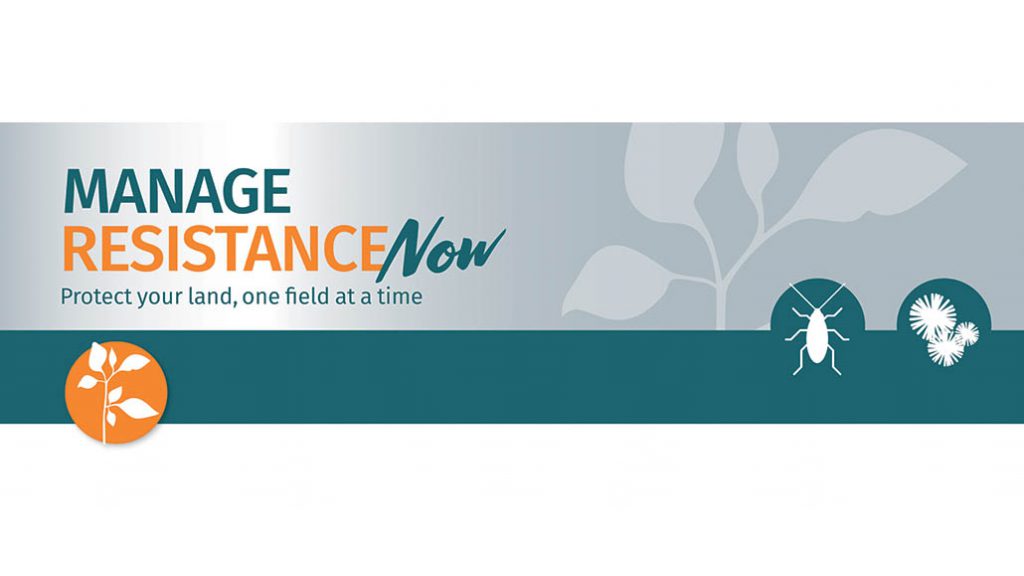Manage resistance now
PROTECT YOUR LAND, ONE FIELD AT A TIME

HERBICIDE RESISTANCE COSTS Canadian farmers an estimated $1.1 to $1.5 billion annually due to increased herbicide use and decreased yield and quality.1 Resistant weeds will rob your crop of yield and threaten the productivity and value of your land. Implement weed management programs that provide near-perfect weed control. This will maximize farm profitability and reduce weed seed return to the soil. Ultimately, this will reduce the emergence of herbicide resistant weeds.
Effectively managing resistance in Canada requires a commitment to changing current management practices. It’s critical to adopt best practices to manage resistance and protect crop yield and quality today, ensuring sustainable crop production for the future. Resistance best management practices (BMPs) include a combination of cultural, mechanical, biological, and chemical control measures. Start today, and take it one field at a time.
BEST MANAGEMENT PRACTICES
ROTATE CROPS
Rotating crops within a field each growing season is essential to managing herbicide resistance.
Rotating allows for rotation of herbicide groups, making it more challenging for weeds to develop resistance to repeated use of the same mode of action.
Rotate crops with different seeding and harvesting dates. Risk of weed resistance is shown to be the lowest in fields with fall-seeded crops, forage crops, or where three or more crop types (e.g. cereal, oilseed, pulse) are grown over a six-year period.
Include crops that compete well with weeds. Plant a range of different crops including a mix of dicots and monocots, winter and spring planted, and annuals and perennials in your rotation.
MIX AND ROTATE HERBICIDES
Rotate herbicides within and between growing seasons. Use herbicide mixtures and rotate the mixtures for even more impact.
Rotate the use of one herbicide group with other herbicide group(s) that control the same weeds in a field. Rotate groups both during a growing season and across years in a field. “Keep the weeds guessing as to what’s coming next,” says Hugh Beckie, former research scientist with Agriculture and Agri-Food Canada (AAFC).
Herbicide mixtures — the combination of two or more herbicides having different modes of action applied as a single mixture — should be used to delay the onset of resistance to any herbicide. You can mix various combinations of herbicides according to label instructions. Use the recommended label rate of each herbicide for maximum weed kill.
Rotate from one herbicide mix to another during a growing season and from one season to the next. It’s easy for weeds to become resistant to simple, predictable weed control. Mixing and rotating makes it unpredictable for weeds and creates diversity for your crop plan.
For a mixture to truly be multi-mode of action, both modes of action need to be effective on the same weed species. If you are targeting one weed species, ensure the herbicides you are using target that weed species.
Consider herbicide layering if there are weed escapes after a soil-applied herbicide in the fall or early spring. For example, follow up with a post-emergent application with different modes of action that target the same weed species during the growing season. This can improve weed control and increase your return on investment even in the absence of resistance.
Using below-label rates of herbicides can contribute to the development of resistance. Use the full rate, timing, and water volume indicated on the label.
SCOUT YOUR FIELDS
Survey your weed populations before spraying so that your weed management is field- and site-specific. Scout fields after herbicide application so that you know how successful you have been in controlling the targeted weeds. This can result in cost savings by reducing herbicide use. For example, in the northern Great Plains, where wild oat is the target weed, site-specific herbicide application on spring cereal crops resulted in higher profits compared to uniform herbicide application.2
When scouting, be aware that isolated weeds listed on the herbicide label that survive application should be dealt with. They may not significantly affect yield at this point, but now is the best time to manage in-field weed escapes.
Be mindful of spray techniques. Be aware that low travel and wind speeds will allow for more uniform application. Consider boom stability for more uniform droplet deposit. Also, keep in mind that sub-lethal doses can occur in a field on the periphery or outside of turns and lead to herbicide resistance.
Now is the time to put these practices in place to manage resistance. Keep the long-term value and productivity of your land and help ensure that crop protection tools are still effective for future use. Consult with your crop advisor or visit ManageResistanceNow.ca for more strategies and information. •
1 State of weed resistance in Western Canada and future outlook, Hugh J. Beckie June 2018
2 Van Wychen LR, Luschei EC, Bussan AJ and Maxwell BD, Accuracy and cost effectiveness of GPS-assisted wild oat mapping in spring cereal crops. WeedSci50:120–129(2002).











